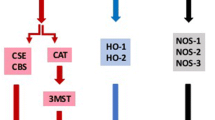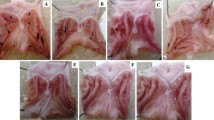Abstract
Gastric cytoprotection is the property of certain substances, particularly prostaglandins, when used in non-antisecretory doses, to protect the gastric mucosa from becoming inflammed and necrotic on being exposed to noxious agents. An association between alterations in endogenous prostaglandins and gastric mucosal damage induced by a number of drugs has also been observed. The process of adaptive cytoprotection in which mild irritants protect the gastric mucosa against the damaging effects of various necrotizing agents has been shown to be prostaglandin mediated. However, the exact mechanisms underlying this cytoprotective activity have still not been elucidated although a number of hypotheses have been proposed. Recently, thromboxanes, leukotrienes and endogenous sulfhydryls have also been suggested to be involved in the pathogenesis of gastric mucosal damage induced by various necrotizing agents. This review attempts to provide an uptodate appraisal of the concept, methodology, mechanisms and implications of this phenomenon and suggests that prostaglandins and endogenous sulfhydryls may play a significant role in the pathogenesis of gastric ulceration and may serve an important function in maintaining normal gastric mucosal integrity.
Similar content being viewed by others
References
A. Robert,Antisecretory, anti-ulcer, cytoprotective and diarrheogenic properties of prostaglandins. InAdvances in Prostaglandins and Thromboxane Research. Vol. 2, pp. 507–520 (Eds B. Samuelsson and R. Paoletti) Raven Press, New York 1976.
A. Robert,Cytoprotection by prostaglandins. Gastroenterology77, 761–767 (1979).
A. Robert, J. E. Nezamis, C. Lancaster and A. J. Hanchar,Cytoprotection by prostaglandins in rats. Gastroenterology77, 433–443 (1979).
U. Valcavi, R. Caponi, A. Brambilla, M. Palmira, F. Minoja, F. Bernini, R. Mustani and R. Fumagalli,Gastric antisecretory, anti-ulcer and cytoprotective properties of 9-hydroxy-19, 20-bis-norprostanoic acid in experimental animals. Arzneim. Forsch.32, 657–663 (1982).
P. Del Soldato, S. Daniotti, D. Foschi, G. Toti and V. Rovati,Curative and preventive cytoprotection of PGE 2,pirenzepine and ranitidine in rat ulcers. Drugs Exptl. and Clin. Res.9, 243–247 (1983).
P. Schiantarelli, S. Cadel and G. C. Folco,Gastroprotective effects of morniflumate, an esterified anti-inflammatory drug. Arzneim. Forsch.34, 885–894 (1984).
L. Varin, P. Del Soldato, D. Foschi and M. De Rosa,Further evidences on gastric cytoprotection exerted by pirenzepine. Pharmacol. Res. Commun.16, 653–665 (1984).
Y. Isobe, H. Hirose, M. Muramatsu and H. Aihara,Cytoprotective effect of sofalcone in the rat gastric mucosa. Arzneim. Forsch.35, 138–141 (1985).
F. Barzaghi, R. Cesana, F. Delevallee, R. Fournex, A. Nencioni, J. C. Vincent and R. Deraedt,Gastric cytoprotective, antisecretory and anti-ulcer activities of (E)-4-oxo-4-(3,4,5-trimethoxyphenyl)-2-butenoic acid (RU 38086). Arzneim. Forsch.78, 173–180 (1983).
A. Robert, J. R. Schultz, J. E. Nezamis and C. Lancaster,Gastric antisecretory and anti-ulcer properties of PGE 2,15-methyl PGE 2 and 16,16-dimethyl PGE 2:intravenous, oral and intrajejunal administration. Gastroenterology70, 359–370 (1976).
A. Robert, J. E. Nezamis, C. Lancaster and A. I. Hanchar,Endogenous formation of prostaglandins prevents gastric necrosis produced by ethanol and thermal injury. Physiologist20, 79 (1977).
A. Robert, C. Lancaster, A. I. Hanchar and J. E. Nezamis,Mild irritants prevent gastric necrosis through prostaglandins formation: histological study. Gastroenterology74, 1086 (1978).
A. Robert, J. E. Nezamis, C. Lancaster, J. P. Davis, S. V. Field and A. Hanchar,Mild irritants prevent gastric necrosis through “adaptive cytoprotection” mediated by prostaglandins. Am. J. Physiol.245, G113-G121 (1983).
T. K. Chaudhary and A. Robert,Prevention by mild irritants of gastric necrosis produced in rats by sodium taurocholate. Fed. Proc.37, 303 (1978).
S. J. Konturek, T. Brzozowski, J. Piastucki, T. Radecki, A. Dembinski and A. Dembinska-Kiec,Role of locally generated prostaglandins in adaptive gastric cytoprotection. Dig. Dis. Sc.27, 967–971 (1982).
H. A. Caramichael, L. M. Nelson and R. I. Russel,Cimetidine and prostaglandin: evidence for different modes of action on the rat gastric mucosa. Gastroenterology74, 1229–1232 (1978).
A. Robert,Prostaglandins and digestive diseases. InAdvances in Prostaglandins and Thromboxane Research, Vol. 8, pp. 1533–1541 (Eds B. Samuelsson, P. W. Ramwell and R. Paoletti). Raven Press, New York 1980.
S. Szabo, J. S. Trier, A. Brown, J. Schnoor, H. D. Homan and J. C. Bradford,A quantitative method for assessing the extent of experimental gastric erosions and ulcers. J. Pharm. Methods13, 59–66 (1985).
F. Ueda, S. Aratani, K. Mimura, A. Nomura and H. Enomoto,Effect of 2,4-diamino-6-(2,5-dichlorophenyl)-S-triazine maleate (MN-1695) on gastric mucosal damage induced by various necrotizing agents in rats. Arzneim. Forsch.34, 478–484 (1984).
P. H. Guth, D. Aures and G. Paulsen,Topical aspirin plus HCl gastric lesions in the rat. Cytoprotective effect of prostaglandins, cimetidine and probanthine. Gastroenterology76, 88–93 (1979).
S. J. Konturek, T. Radecki, T. Brzozowski, J. Piastucki, A. Dembinska-Kiec and A. Zmuda,Gastric cytoprotection by prostaglandins, ranitidine and probanthine in rats. Canad. J. Gastroenterol.16, 7–12 (1981).
J. Hagel, H. Renner, M. Hirsch, G. Weig, B. Kaduk, H. Ruppin and W. Domschke,Gastric cytoprotection by antacids and papavarine in rats. Hepato-Gastroenterol.29, 271–274 (1982).
S. J. Konturek, T. Brzozowski, T. Radecki and J. Piastucki,Gastric cytoprotection by pirenzepine. Role of endogenous prostaglandins. Scand. J. Gastroenterol.17 (Suppl. 72), 255–259 (1982).
A. Robert, C. Lancaster, J. P. Davis, S. O. Field and J. E. Nezamis,Distinction between anti-ulcer effect and cytoprotection. Scand. J. Gastroenterol.19 (Suppl. 101), 69–72 (1984).
J. Puurunen,Effect of prostaglandin E 2,cimetidine and atropine on ethanol induced gastric mucosal damage in the rat. Scand. J. Gastroenterol.15, 485–488 (1980).
A. Tarnawski, D. Hollander, H. Gergely and J. Stachura,Comparison of antacids, sucralfate, cimetidine and ranitidine in protection of gastric mucosa against ethanol injury. Gastroenterology34, 1331 (1983).
S. Szabo and K. H. Usadel,Cytoprotection-organoprotection by somatostatin: gastric and hepatic lesions. Experientia38, 254–256 (1982).
S. Szabo, J. S. Trier and P. W. Frankel,Sulfhydryl compounds may mediate gastric cytoprotection. Science214, 200–202 (1981).
R. K. H. Wong, B. Boedeker, T. M. Hickey, D. S. Wilkinson and L. F. Johnson,Lithium chloride: Protective and antisecretory properties in rats. Gastroenterology87, 362–371 (1984).
S. J. Konturek, T. Brzozowski and T. Radecki,Protective action of omeprazole, a benzimidazole derivative on gastric mucosal damage by aspirin and ethanol in rats. Digestion27, 159–164 (1983).
B. Kollberg, J. I. Isenberg and C. Johansson,Cytoprotective effect of omeprazole on the rat gastric mucosa. InMechanisms of Mucosal Protection in the Upper Gastrointestinal Tract, pp. 351–355 (Eds A. Allen, G. Flemstrom, A. Garner, W. Silen and L. A. Twinberg) Raven Press, New York 1984.
A. A. Van Kolfschoten, P. Zandberg, L. P. Jager and J. Van Noordwijk,Protection by paracetamol against various gastric irritants in rat. Toxicol. and Appl. Pharmacol.69, 37–42 (1983).
A. Robert,Gastric cytoprotection by sodium salicylate. Prostaglandins21 (Suppl.) 139–146 (1981).
S. Malandrino, G. Campagnoli, M. Borsa, R. Guidoboni and G. C. Tonon,Prevention of gastric mucosal lesions in rats by tripotassium dicitratobismuthate. Arzneim. Forsch.34, 30–31 (1984).
D. Hollander, A. Tarnawski, D. Cummings, W. J. Krause, H. Gergely and R. D. Zipser,Cytoprotective action of antacids against alocohol induced gastric mucosal injury. Morphologic, ultrastructural and functional time sequence analysis. Gastroenterology86, 1114 (1984).
A. Tarnawski, D. Hollaner, H. Gergely and J. Stachura,Comparison of antacid, sucralfate, cimetidine, and ranitidine in protection of the gastric mucosa against ethanol injury. Amer. J. Med.79, 19–23 (1985).
I. Szelenyi and K. Brune,Possible role of sulfhydryls in mucosal protection induced by aluminium hydroxide. Dig. Dis. Sci.31, 1207–1210 (1986).
J. Singh,Prostaglandins release from rat stomach following vagal stimulation or administration of acetylcholine. Eur. J. Pharmac.65, 39–48 (1980).
N. K. Boughton-Smith and B. J. R. Whittle,Stimulation and inhibition of prostaglandin formation in the rat gastric mucosa and ileum in vitro by anti-inflammatory agents. Br. J. Pharmac.78, 173–180 (1983).
S. J. Konturek, I. Piastucki, T. Brzozowski, T. Radecki, A. Dembinska-Kiec, A. Zmuda and R. Gryglewski,Role of prostaglandins in formation of aspirin-induced gastric ulcers. Gastroenterology80, 4–9 (1981).
B. J. R. Whittle, G. A. Higgs, K. E. Eakins, S. Moncada and J. R. Vane,Selective inhibition of prostaglandin production on inflammatory exudates and gastric mucosa. Nature (London)284, 271–273 (1980).
T. A. Miller,Protective effects of prostaglandins against gastric mucosal damage: current knowledge and proposed mechanisms. Am. J. Physiol.245, G601-G623 (1983).
A. Robert,Mechanism of cytoprotection. InIUPHAR 9th International Congress of Pharmacology, London. Proceedings Vol. 4, pp 355–359 (Eds W. Paton, J. Mitchell and P. Turner). The Macmillan Press Ltd., London 1984.
G. L. Kauffman and B. J. R. Whittle,Gastric vascular actions of prostanoids and the dual effect of arachidonic acid. Am. J. Physiol.242, G582-G587 (1982).
B. J. R. Whittle, G. L. Kauffman and S. Moncada,Vasoconstriction with thromboxane A 2 induces ulceration of the gastric mucosa. Nature (London)292, 472–474 (1981).
B. J. R. Whittle and S. Moncada,Ulceration induced by an endoperoxide analogue and by indomethacin in the canine stomach. InAdvances in Prostaglandin, Thromboxane and Leukotriene Research, Vol. 12, pp. 373–378 (Eds B. Samuelsson, R. Paoletti and P. Ramwell). Raven Press, New York 1983.
B. J. R. Whittle and S. Moncada,Pharmacological interactions between prostacyclin and thromboxanes. Br. Med. Bull.39, 232–238 (1983).
S. J. Konturek, T. Brzozowski, I. Piastucki, T. Radecki and A. Dembinska-Kiec,Role of prostaglandin and thromboxane biosynthesis in gastric necrosis produced by taurocholate and ethanol. Dig. Dis. Sci.28, 154–160 (1983).
B. J. R. Whittle,The potentiation of taurocholate induced rat gastric erosions following parenteral administration of cyclooxygenase inhibitors. Br. J. Pharmac.80, 545–551 (1983).
B. J. R. Whittle,Cellular mediators in gastric damage: actions of thromboxane A 2 and its inhibitors. InMechanism of Mucosal Protection in the Upper Gastrointestinal Tract, pp. 295–301 (Eds A. Allen, A. Garner, G. Flemstrom, W. Silen and L. A. Turnberg). Raven Press, New York 1984.
B. J. R. Whittle, N. Oren-Wolman and P. H. Guth,Gastric vasoconstrictor actions of leukotrienes C 4,PGF 2α and the thromboxane mimetic U-46619 on rat submucosal microcirculation in vivo. Am. J. Physiol.248, G580-G586 (1985).
B. M. Peskar, K. Lange, U. Hoppe and B. A. Peskar,Ethanol stimulates formation of leukotriene C 4 in rat gastric mucosa. Prostaglandins31, 283–293 (1986).
R. G. Pendleton and J. R. Stavorski,Evidence for different leukotriene receptors in gastric mucosa. Eur. J. Pharmac.125, 297–299 (1986).
A. Rosam, J. L. Wallace and B. J. R. Whittle,Potent ulcerogenic actions of platelet activating factor on the stomach. Nature (London)319, 54–56 (1986).
J. L. Wallace and B. J. R. Whittle,Picomole doses of platelet activating factor predispose the gastric mucosa to damage by topical irritants. Prostaglandins31, 989–998 (1986).
J. L. Wallace and B. J. R. Whittle,Effects of inhibitors of arachidonic acid metabolism on Paf-induced gastric mucosal necrosis and haemoconcentration. Br. J. Pharmac.89, 415–422 (1986).
T. Mizui and M. Doteuchi,Effect of polyamines on acidified ethanol-induced gastric lesions in rats. Japan J. Pharmacol.33, 939–945 (1983).
E. Ezer,Sodium salicylate is a unique gastrointestinal protective compound in rat. Digestion31, 168 (1985).
D. Dupuy and S. Szabo,Biochemical analysis of sulfhydryls in gastric mucosal protection. Digestion31, 165 (1985).
R. Fumagalli, R. Caponi, A. Corsini, A. Brambilla, M. Palmira, F. Bernini and U. Valcavi,Nonprotein sulfhydryls as possible components of the protective effect of Rosaprostol on the rat gastric mucosa. Prostaglandins29, 467–474 (1985).
T. Mizui and M. Doteuchi,Lipid peroxidation: A possible role in gastric damage induced by ethanol in rats. Life. Sci.38, 2163–2167 (1986).
Author information
Authors and Affiliations
Rights and permissions
About this article
Cite this article
Parmar, N.S., Tariq, M. & Ageel, A.M. Gastric cytoprotection: a critical appraisal of the concept, methodology, implications, mechanisms and future research prospects. Agents and Actions 22, 114–122 (1987). https://doi.org/10.1007/BF01968826
Received:
Accepted:
Issue Date:
DOI: https://doi.org/10.1007/BF01968826




